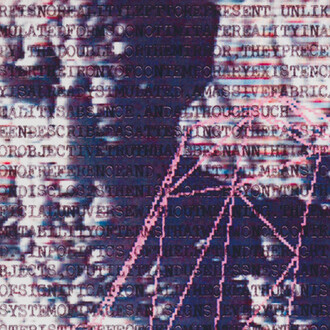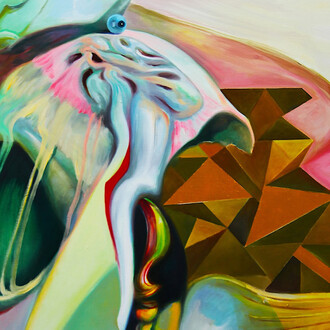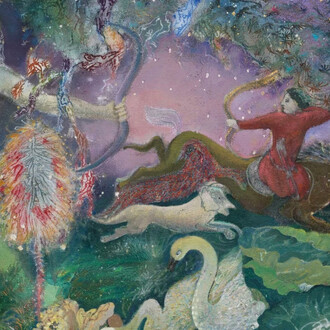Inventing vocabularies has been and remains my mode of art making.
(Tina Girouard)
Magenta Plains is proud to present Tina Girouard’s first gallery exhibition in New York City since 2012, focused on a crucial body of work created in the late 1970s during second-wave feminism and never before exhibited: Girouard's DNA-icons. The gallery exhibition is concurrent with a traveling posthumous retrospective showcasing over forty years of the artist’s practice organized by Rivers Institute for Contemporary Art & Thought at the Center for Art, Research, and Alliances (CARA), previously on view at the Ogden Museum of Southern Art, and another simultaneous presentation at Anat Ebgi gallery in New York. The exhibition title is synonymous with a large-scale tapestry layered with symbolic content on view at CARA.
Tina Girouard was a Louisiana-born, vanguard artist working in the fields of performance, film, textile, printmaking and socially-based practices. Her career has taken place largely outside the gallery system owing to a preference for non-profit organizations and exhibition venues with broader public audiences and community involvement. Notably, her work came to be part of the renegade mid1970s movement known as Pattern and Decoration. Girouard's DNA-Icons were produced at the end of a decade when the artist lived in Chinatown, just a few blocks south of the gallery. Made with the assistance of the Fabric Workshop Museum in Philadelphia, these hanging textiles represent a fusion of two crucial dimensions of Girouard's practice: her efforts in elevating found domestic surfaces such as fabric and her goal to create a universal language.
Each of the silkscreened symbols centrally placed on fabric squares are drawn from a personal lexicon Girouard developed from sources such as cave paintings, ancient petroglyphs, pictograms, hieroglyphs, contemporary cartoons, and international signage. Some of the symbols are figurative, while others are slightly more abstract but still relatable; geometric lines and shapes, abstract assemblies that evoke limbs, water, or wind. Functioning as singular characters on found fabric, words are isolated or built into phrases depending on the permutation desired by Girouard, referencing the elements, the self, mortality, and activities, such as: ‘Air,’ ‘Earth,’ ‘Water,’ ‘Fire,’ ‘Land,’ ‘Swamp,’ ‘House,’ ‘Death,’ ‘Child,’ ‘Tina,’ and ‘Gonna Go.’ This personal "pictionary" of over 400 distinct symbols she developed are represented across the works in this exhibition, with distinct narratives being formed by each individual piece.
In her larger body of work, Girouard used cultural symbols associated with the daily life of women, labor, and habitation, creating installations and environments that combined performative actions with the layering of objects. Besides fabric, Girouard used other materials found in the home such as collections of wallpaper, linoleum, stamped steel ceiling and sequins. The DNA-Icons series represents one of the most important dimensions of Girouard's artistic ethos relating to the communion she so embodied.
Born in DeQuincy, Louisiana in 1946, Tina Girouard received a B.F.A. in Fine Art from the University of Southwest Louisiana in 1968 and moved to New York City in 1969 with the Louisiana-born saxophonist, composer and collaborator Richard “Dickie” Landry. Upon moving to New York, Girouard and Landry moved into an apartment at 10 Chatham Square in Chinatown with the painter Mary Heilmann. The trio’s home soon became a center of avant-garde art, music and performance in New York as well as a meeting ground for other Louisiana-born artists working in the Post-Minimalist scene, such as Lynda Benglis and Keith Sonnier.
While living in New York, Girouard shaped many significant postwar avant-garde groups and art movements including: The Anarchitecture group; The interdisciplinary experiments in the lofts at 112 Greene Street; The artist-run restaurant Food in SoHo; and the Pattern and Decoration movement. After a devastating studio fire in 1978, Girouard and Landry moved back to Louisiana and created a studio near Lafayette. From this new home, Girouard began connecting and collaborating with local artists in the region as a way of supporting Louisiana francophone culture. This eventually led to the founding of the Artists’ Alliance in Lafayette in 1986 and the establishment of the Festival International de Louisiane–an international festival that brought together music, dance, theater, visual and culinary arts from francophone Europe, Africa, the Americas and the Caribbean. It was during these projects that Girouard became interested and invested in Haitian art.
In 1990, Girouard moved to Port-au-Prince, Haiti and established a studio there, which she kept until 1995. During that time, Girouard studied alongside Haitian artists and learned to make traditional vodou flags, collaborating extensively with Antoine Oleyant and Georges Valris. In doing so she reinvented her artistic vocabulary, created a new body of work in sequins, and authored a book entitled Sequin artists of Haiti (1994) to honor her collaborators and mentors. Girouard died after a stroke in April 2020 at her home in Cecilia, LA.
Girouard has an exhibition history that includes a 1983 mid-career retrospective mounted at the Rufino Tamayo Museum in Mexico City, and international events such as the 1980 Venice Biennale, the 1977 Paris Biennale, 1977 Documenta VI and 1972 Documenta V, Kassel. Girouard’s work has been exhibited widely at galleries and museums including: Leo Castelli Gallery, The Kitchen, Walker Art Center, New Orleans Museum of Art, Museum of Contemporary Art Chicago, Palais des BeauxArts Brussels, Holly Solomon Gallery, David Zwirner, the Museum of Contemporary Art Los Angeles, and the New Museum. Her work was recently on view in the exhibition With Pleasure: Pattern and Decoration in American Art 1972 – 1985 curated by Anna Katz, originating at MOCA Los Angeles, which traveled to the Hessel Museum of Art, Bard College, NY.
Girouard’s work is in the permanent collections of the Hessel Museum of Art, Center for Curatorial Studies, Bard College, Annandale-on-Hudson, NY; Institute of Contemporary Art, University of Pennsylvania, Philadelphia, PA; Ludwig Forum fur International Kunst Aachen, DE; Rufino Tamayo Museum, Mexico City, Mexico; and Stedelijk Museum Actuele Kunst, Gent, Belgium.
















